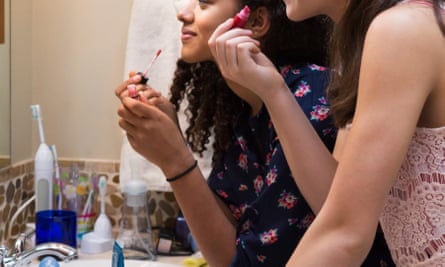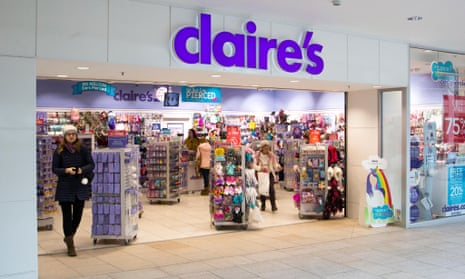Claire’s Stores Inc, an international accessories and cosmetics retailer tailored to kids and teens, has a motto: “We make memories”.
But its customers may have been alarmed after asbestos, a cancer-causing material that can stay in the body for many years, was found in several of Claire’s makeup products in the US.
On 6 June, the US Food and Drug Administration (FDA) issued a safety alert warning people to stop using a Claire’s Jojo Siwa Makeup Set, as well as a contouring palette sold by Beauty Plus Global because the products had tested positive for asbestos.
Both companies had issued a voluntary recall of the products at the end of May.
The June warning came just two months after the FDA flagged three other Claire’s products – an eye shadow, compact powder and contour palette – for asbestos. The agency issued a safety warning on 5 March for consumers after, it said, Claire’s initially refused to recall the products in question.
“Claire’s stands behind the safety of our products,” the company said in an emailed statement to the Guardian on Friday. “All our cosmetic products are reviewed by two cosmetic safety assessors and undergo rigorous analysis and assessment before reaching consumers.” The company also began replacing talc with a cosmetic-grade mica in all its products last year.
Claire’s isn’t the only tween company with an asbestos problem on its hands. The FDA’s March warning also confirmed a product called Just Shine Shimmer Powder, sold by youth-focused retailer Justice, also tested positive for asbestos. Justice had recalled the asbestos-tainted product, along with seven other suspect items, in 2017 after product testing commissioned by a North Carolina news outlet found asbestos and heavy metals.

Why does asbestos keep turning up in kids’ makeup?
Asbestos is a group of six minerals that occur naturally in the earth. It is often in close proximity to deposits of talc, which is ground into talcum powder to make a range of cosmetics and personal care products, like baby powder, blush, eye shadow, foundation and more. During mining, talc can be contaminated with asbestos, which can then potentially end up in consumer products.
Firms say they have strong quality controls to identify it.
Environmental health advocates say a lack of stronger regulation in the cosmetics industry is the real issue. “It is appalling that it’s perfectly legal to sell kids makeup in this country contaminated with asbestos – a known human carcinogen,” Janet Nudelman, director of the Campaign for Safe Cosmetics, said via email. “I don’t know what’s worse – asbestos in kids’ products or the fact that the FDA can’t do anything about it.”
There are no laws in the United States that require manufacturers to test the safety of cosmetics ingredients before going to market. The FDA oversees cosmetics and personal care products, but has limited authority over manufacturers. The agency cannot force companies to recall products found to be dangerous, and companies are not required to share safety information with the FDA.
Asbestos is only banned for certain uses in the United States. The EPA is currently doing a risk evaluation on asbestos under the Toxic Substances Control Act. Cosmetics contamination is not an area the EPA is currently looking at under the TSCA evaluation.
Health advocates and the FDA say the extent of asbestos contamination in cosmetics remains unknown. While recent reports have been focused on children’s cosmetics, asbestos could potentially be present in any product with talc.
“We have absolutely no idea how often asbestos is found in cosmetics containing talc,” said Nudelman, who is also director of program and policy of Breast Cancer Prevention Partners, a science-based policy and advocacy group. She advised consumers to avoid using products with talc unless it is known to be asbestos-free, and warned that no talc products should be used in the pelvic area because of links to ovarian cancer.
In 2009 the FDA sampled 38 cosmetics products and found no traces of asbestos. “Nonetheless, these results indicate that any talc-containing product could contain asbestos if not adequately sourced with quality controls to assure that the talc is asbestos-free,” an FDA spokesperson said in an emailed statement.
“Because FDA law is so outdated, it leaves it to the general public and NGOs and individual moms to be scrutinizing these products,” said Liz Hitchcock, acting director of Safer Chemicals, Healthy Families, an advocacy group focused on toxic chemicals.
The FDA said it does not have the capability to test for asbestos on its own and is reliant on outside labs. The agency was prompted to investigate products sold by Claire’s and Justice after media reports on asbestos findings, including a lab analysis commissioned by the mother of a six year-old in Rhode Island.
The rules for FDA’s authority over cosmetics products, laid out in the Federal Food Drug and Cosmetics Act, have not been updated since 1938, a fact mentioned by FDA Commissioner Scott Gottlieb and Susan Mayne, director of the Center for Food Safety and Applied Nutrition, in a statement on the March asbestos findings.
“To significantly shift the safety paradigm of cosmetics in the US, we would need to work with stakeholders, including Congress, to modernize the outdated regulatory framework that the FDA has been operating under for more than 80 years when it comes to cosmetics,” the statement read.
Asked by the Guardian if US customers concerned about asbestos exposure should avoid products containing talc, the FDA said in a statement: “The FDA’s findings are specific to the products tested and do not signify the presence of asbestos in any other products on the market.
“In a 2009 survey, conducted for the FDA, 38 samples were tested and did not show any evidence of asbestos. A broad range of products were tested including eye shadow, blush, foundation, face and body powders.
“Nonetheless, these results indicate that any talc-containing product could contain asbestos if not adequately sourced with quality controls to assure that the talc is asbestos-free.
“Manufacturers have a responsibility to ensure that their cosmetics are safe, which includes ensuring that the source of their talc and finished product is asbestos-free.”
